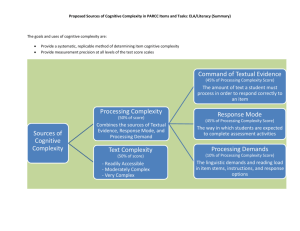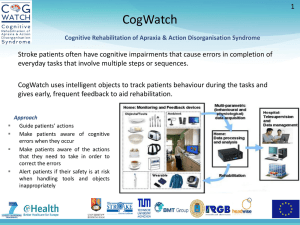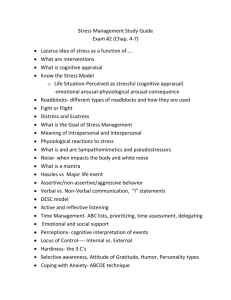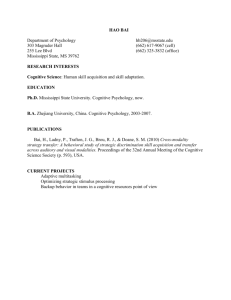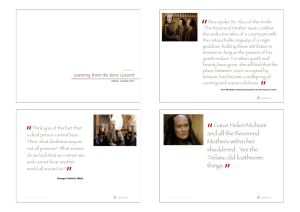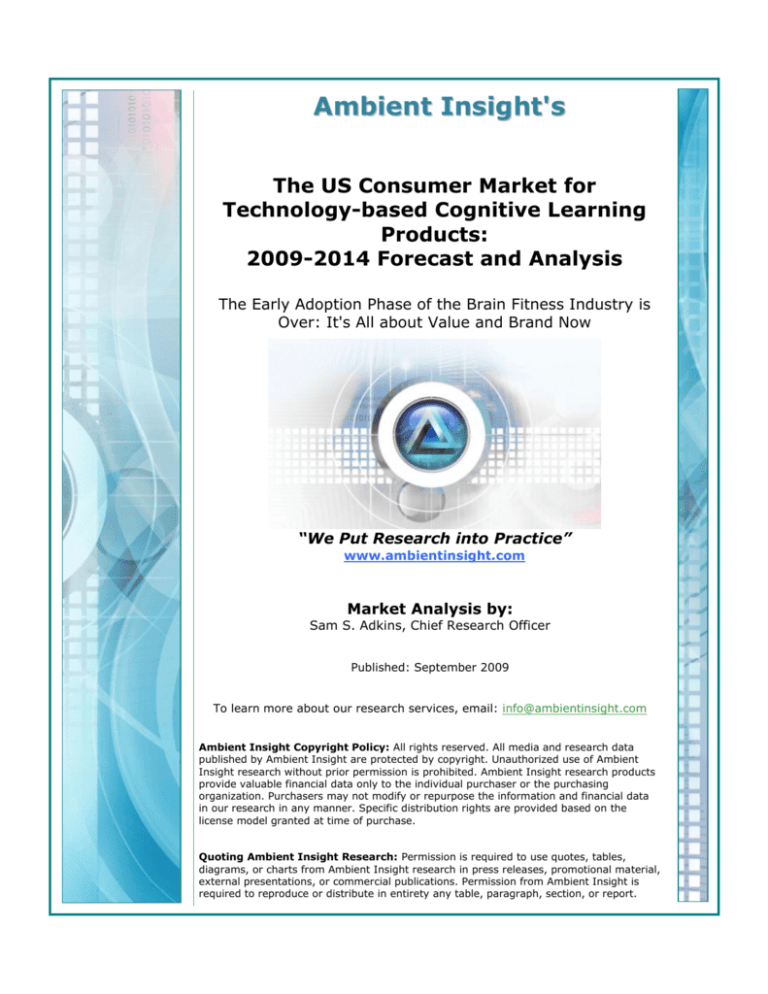
Ambient Insight's
The US Consumer Market for
Technology-based Cognitive Learning
Products:
2009-2014 Forecast and Analysis
The Early Adoption Phase of the Brain Fitness Industry is
Over: It's All about Value and Brand Now
“We Put Research into Practice”
www.ambientinsight.com
Market Analysis by:
Sam S. Adkins, Chief Research Officer
Published: September 2009
To learn more about our research services, email: info@ambientinsight.com
Ambient Insight Copyright Policy: All rights reserved. All media and research data
published by Ambient Insight are protected by copyright. Unauthorized use of Ambient
Insight research without prior permission is prohibited. Ambient Insight research products
provide valuable financial data only to the individual purchaser or the purchasing
organization. Purchasers may not modify or repurpose the information and financial data
in our research in any manner. Specific distribution rights are provided based on the
license model granted at time of purchase.
Quoting Ambient Insight Research: Permission is required to use quotes, tables,
diagrams, or charts from Ambient Insight research in press releases, promotional material,
external presentations, or commercial publications. Permission from Ambient Insight is
required to reproduce or distribute in entirety any table, paragraph, section, or report.
The US Consumer Market for Technology-based Cognitive Learning Products:
2009-2014 Forecast and Analysis, Ambient Insight, LLC
Table of Contents
List of Tables ............................................................................... 3
List of Figures .............................................................................. 3
Executive Overview ...................................................................... 4
Key Findings ......................................................................................... 5
Methodology, Scope, and Product Definitions ................................... 8
Scope .................................................................................................. 8
Product Definitions ................................................................................ 9
Related Research .................................................................................12
2009-2014 Forecast by Cognitive Learning Type ............................ 13
Cognitive Assessments ..........................................................................13
Children ........................................................................................................ 14
Adults ........................................................................................................... 15
Cognitive and Intelligent Tutors .............................................................17
Math ............................................................................................................. 17
Reading ......................................................................................................... 18
General Purpose Cognitive and Intelligent Tutors ................................................ 19
Cognitive Fitness Games and Applications ...............................................20
Mobile Brain Trainers ...................................................................................... 21
Brain Fitness Games and Applications................................................................ 24
PC-based Brain Trainer Games ............................................................................ 24
Brain Fitness Applications ................................................................................... 24
Memory Training ............................................................................................... 25
Brain Fitness for Children .................................................................................... 26
Growing Supply Chain ........................................................................................ 27
Market Inhibitors ........................................................................ 28
Barriers-to-entry ..................................................................................28
Saturation and Maturation .....................................................................29
Pricing Pressures ..................................................................................30
Brand Awareness .................................................................................31
Market Catalysts ........................................................................ 32
Demand and Demographics ...................................................................32
Expanding Retail Distribution Channel .....................................................33
The Top Four Value Propositions in the Wide Adoption Phase .....................33
Revenue Opportunities and Recommendations ............................... 35
2009-2014 Mobile Brain Trainer Market Share by Operating System ..................... 36
Index of Suppliers ...................................................................... 39
For more information about this report, email: sam@ambientinsight.com
2
The US Consumer Market for Technology-based Cognitive Learning Products:
2009-2014 Forecast and Analysis, Ambient Insight, LLC
List of Tables
Table 1 - 2009-2014 US Consumer Revenue Forecasts for Cognitive
Learning Products by Product Type (in $US Millions) ...................................13
Table 2 - 2009-2014 US Consumer Revenue Forecasts for Cognitive
Fitness Products by Two Sub-Product Types (in $US Millions) ......................20
List of Figures
Figure 1 – What are US Consumer Buying? 2009-2014 Growth Rates
across all Technology-based Learning Product Types ................................... 4
Figure 2 – What are US Consumer Buying? 2009-2014 Growth Rates
for Three Cognitive Learning Product Types ................................................ 7
Figure 3 – Cognitive Tutors Solve Bloom's 2 Sigma Problem ........................10
Figure 4 –2009-2014 US Consumer Revenue Forecasts for Cognitive
Fitness Products by Two Sub-Product Types (in $US Millions) ......................21
Figure 5 –2009 Mobile Brain Trainer Market Share by Game Title .................22
Figure 6 –2009 Snapshot of the Technology-based Cognitive Learning
Product Pipeline in the US Consumer Segment ...........................................29
Figure 7 –2009 Mobile Brain Trainer Market Share by Operating
System .................................................................................................36
Figure 8 –2014 Mobile Brain Trainer Market Share by Operating
System .................................................................................................37
For more information about this report, email: sam@ambientinsight.com
3
The US Consumer Market for Technology-based Cognitive Learning Products:
2009-2014 Forecast and Analysis, Ambient Insight, LLC
Executive Overview
The US consumer demand for technology-based Cognitive Learning
products is growing by a five-year compound annual growth rate (CAGR) of
32.4%. Annual consumer expenditures on these products will reach $61.1
million in 2009.
In the 2009 market, consumers are spending a total of $14.4 billion on
training and education. The vast majority (89%) of that is still spent on
classroom events and print-based products. Consumers are spending $1.6
billion on technology-based learning products and the demand for these
products is growing by 12.9%.
In contrast, the demand for Cognitive Learning is growing two and a half
times that rate and it is the fastest growing product type in the consumer
segment, followed by Collaborative-Social Learning and Mobile Learning.
Figure 1 – What are US Consumer Buying? 2009-2014 Growth Rates across
all Technology-based Learning Product Types
(Source: The US Consumer Market for Technology-based Learning Products: 2009-2014
Forecast and Analysis, Ambient Insight, LLC)
This report breaks out revenues for three types of Cognitive Learning
products:
Cognitive assessments
Cognitive and intelligent tutors
Cognitive fitness games and applications
For more information about this report, email: sam@ambientinsight.com
4
The US Consumer Market for Technology-based Cognitive Learning Products:
2009-2014 Forecast and Analysis, Ambient Insight, LLC
Additionally, revenue for the cognitive fitness product type is further
broken out by two sub-product types: Mobile brain trainers and PC-based
brain fitness games and applications.
The cognitive fitness industry has left the early adoption phase and entered
the wide adoption phase. In an early adoption phase, also called the
market creation phase, product innovation is the key to attract new
customers. In the wide adoption phase, also called the value creation
phase, the customer base grows and new suppliers enter the market at a
rapid pace. In this phase, new and compelling features are required to
keep customers, differentiate products, and compete effectively.
The current market favors suppliers that can provide unique value to
increasingly well-informed and savvy customers.
Key Findings
Key findings discussed in this report include:
Suppliers have successfully created a new market for new types of
products that appeal to a large and diverse demographic on two
ends of the age spectrum: early childhood and the elderly
The barriers-to-entry are relatively high for advanced products, but
a steady stream of new suppliers are entering the market with lowend products
The confusion prevalent in the early adoption phase of the market
has abated and customers are now relatively well-informed about
the value of the products
A significant amount of venture capital is being invested in the
companies that compete in the consumer segment
A vibrant retail reseller channel has emerged in the last year and
the distribution channel is in place for wide adoption
Suppliers are experimenting with various business models and a
"branding frenzy" is underway with a wide range of suppliers
rebranding their products as brain training and brain fitness to tap
into the demand
The competitive landscape is heating up with new and old suppliers
competing for brand, revenue, and market share
The most significant catalyst in the consumer segment is the interest in the
concept of brain fitness coming from the aging population. As of 2009,
there are 62 million people over 55 in the US representing 21% of the total
population. This demographic is growing by over 2.1 million people a year
and will reach almost 73 million by 2014. The suppliers are now
successfully (and aggressively) marketing to this demographic.
An interesting trend is the emergence of new products designed for the 16
million children in the 4-7 years old age. In the last year, several legacy
suppliers that previously served the adult population have released
products designed for young children. Suppliers of sophisticated clinical
learning disabilities and dyslexia solutions designed for children are
expanding to wider audiences and marketing their products as generalpurpose brain fitness solutions for children. There are over 45 million
For more information about this report, email: sam@ambientinsight.com
5
The US Consumer Market for Technology-based Cognitive Learning Products:
2009-2014 Forecast and Analysis, Ambient Insight, LLC
children between the ages of 4-15 in the US that are given cognitive
assessments.
Getting new advanced products in the pipeline can be daunting for new
suppliers. It takes a great deal of expertise and capital to develop products
and time to market can be very long. In a wide adoption phase, this can be
a significant inhibitor. Suppliers that can't get to market within the next 1218 months will face stiff competition.
In the meantime, the market is being flooded with low-end products and
suppliers are struggling to differentiate themselves. The current market is
saturated with these low-end products that are either free or sold at very
low prices. In the current phase of the industry price is important, but not
the primary differentiator for consumers. In the forecast period, the market
favors suppliers that create value with more advanced feature-driven
products.
The "hype"
surrounding the brain
fitness and brain
training products still
generates significant
media attention and
potential buyers have
access to a great deal
of new (and archived)
information about the
products.
The confusion surrounding brain trainers and brain fitness that was
prevalent in the early adoption phase of the market has now abated and
customers are relatively savvy buyers. Buyers are now more aware of
brands and are better informed about the types of products on the market.
They know the difference between mass market brain trainer games
designed for entertainment and personalized brain fitness applications
designed to enhance cognitive skills.
Corporations are adding brain fitness to their wellness programs and
commercial fitness centers are integrating cognitive fitness products into
their fitness programs, increasing the brand awareness for specific products
across a younger adult demographic.
The hype and the healthy sales of the products have sparked an increase in
private investment. Ambient Insight considers private investment to be a
leading indicator of future revenue generation. Obviously, investors believe
these companies will be successful. Posit Science garnered $24 million in
private investment in 2004 and 2005 allowing the company to get to
market early. They got $5.6 million in a third round of funding in early
2009.
There was $53.6 million invested in brain fitness companies in 2007 and
2008 with 53% of the funding going to consumer-facing suppliers. In 2008,
Dakim garnered the highest investment receiving $10 million in funding,
followed by CogniFit at $5 million, and Lumos Labs at $3 million. (Source:
Private Investment Trends in the US Learning Technology Industry: 1999-2008 Longitudinal
Analysis, Ambient Insight, LLC)
A new development is the emergence of a rapidly growing retail reseller
channel. This is a fast and low-risk way into the market and represents
significant revenue opportunities for new suppliers that lack the expertise
or capital to develop their own products. The rapid growth of the retail
reseller channel is a primary market catalyst and creates the foundation of
the current wide adoption phase. However, a channel model creates a new
layer of complexity for those suppliers that, to date, have sold directly to
customers or through tightly controlled affiliate programs. Also, volume
For more information about this report, email: sam@ambientinsight.com
6
The US Consumer Market for Technology-based Cognitive Learning Products:
2009-2014 Forecast and Analysis, Ambient Insight, LLC
may increase, but margins drop in a channel model which exacerbates
pricing pressure.
Figure 2 – What are US Consumer Buying? 2009-2014 Growth Rates for
Three Cognitive Learning Product Types
The competitive
landscape is heating up
with new and old
suppliers vying for
revenue and market
share. There are
market leaders, but no
single supplier has a
dominant market
share.
A variety of business models are evolving. Suppliers are experimenting
with reseller, affiliate, direct retail, and subscription-based models. Some
suppliers are also building out ad-based community sites. There are also
hybrid models that offer tiered pricing with basic products offered for free
and more advanced products sold on a fee basis.
A range of suppliers that come from outside the industry are now retooling
their marketing messages and rebranding their products to tap into the
growing customer awareness of the products. For example, publishers of
trivia, puzzle, and strategy games are trying to tap into the demand by
repackaging products as brain training.
As new products come into the pipeline at a steady pace, the demand for
older products is maturing. For example, the once-booming demand for
mobile brain trainer edugames is slowing. It is likely that during the
forecast period a significant "shake-out" will occur in the supply chain.
In the meantime, the demand for Cognitive Learning products is very high
and there are significant revenue opportunities for suppliers that can
compete successfully. The target demographic for these products is
relatively large (and growing) and the demand is still largely untapped.
For more information about this report, email: sam@ambientinsight.com
7
The US Consumer Market for Technology-based Cognitive Learning Products:
2009-2014 Forecast and Analysis, Ambient Insight, LLC
Methodology, Scope, and Product
Definitions
Ambient Insight is an integrity-based market research firm that specializes
in identifying revenue opportunities for suppliers. Principals at Ambient
Insight have been tracking innovation and investment trends in the
learning technology industry since the late 1990's.
Ambient Insight provides market revenue forecasts based on our
proprietary Evidence-based Research Methodology (ERM). The ERM is an
iterative process based on predictive analytics. ERM progresses from
general patterns (the big picture) to very precise granular patterns. It is
used to create a forecast model comprised of relevant predictors.
The forecast model is refined as additional data becomes available.
Ambient Insight triangulates baseline revenues from three analysis vectors:
Supply-side analysis
Demand-side analysis
Product and service analysis
Once the baseline revenues are triangulated, Ambient Insight uses the data
to forecast the Total Addressable Market (TAM). Ambient Insight uses the
data derived from the ERM process literally as evidence to support our
market forecasts.
Ambient Insight gathers market and competitive intelligence from a wide
spectrum of information broadly classified as leading and lagging
indicators. Economic and market conditions are subject to change and the
data in this report are current at the time of publication.
Leading indicators signal future events and include venture capital
investment trends, patent applications, technology-related legislation,
technology standards development, product research trends, technology
infrastructure trends, labor demand, and outsourcing demand.
Lagging indicators, referred to as "rear-view mirror" data, are past events
captured in data that include new vendor activity, M&A activity, executive
hiring patterns, US Economic Census data, SIC and NAICS data, SEC
filings, local and federal government data, Universal Commercial Code
banking reports, public-domain business records, court records, press
releases, and industry association information.
Scope
This report only covers revenues derived from US customers. The
companies that develop the products discussed in the analysis are either
US-based, have established US subsidiaries, or are offshore companies
providing products and services to US buyers.
The analysis in this report covers the technology-based products that are
specifically designed, branded, and marketed as Cognitive Learning
For more information about this report, email: sam@ambientinsight.com
8
The US Consumer Market for Technology-based Cognitive Learning Products:
2009-2014 Forecast and Analysis, Ambient Insight, LLC
products. This includes cognitive assessments, cognitive and intelligent
tutors, brain training games, brain gyms, brain fitness applications, and
cognitive fitness applications.
There are rehabilitation
and clinical-diagnostic
technologies that are
often marketed as
brain fitness
applications. Ambient
Insight does not
categorize products
that are designed for
cognitive rehabilitation
or for clinical diagnosis
as Cognitive Learning
products.
This analysis does not include forecasts for tangible or print-based content,
generic puzzle games, biofeedback products (also known as brain
entrainment), or for stand-alone device-embedded products such as Sega
Toys' Brain Trainer.
Ambient Insight does not categorize clinical diagnostic and clinical
intervention (therapy and treatment) tools designed to diagnose and treat
cognitive disorders as Cognitive Learning products. Ambient Insight does
not categorize inventories primarily used in clinical situations, such as the
Minnesota Multiphasic Personality Inventory (MMPI), as Cognitive Learning
products. Consequently, those products are excluded from this analysis.
Some suppliers have developed products to counteract reading disabilities
and are now marketing their products to gifted children and the elderly.
Suppliers that are expanding into these demographics are included in this
analysis.
Disclaimer:
Ambient Insight analyzes the competitive landscape and supply chain
for Cognitive Learning products and is agnostic about claims or
criticisms surrounding the effectiveness of the products. We never
endorse specific suppliers or products. We do not evaluate, compare,
or rank the effectiveness of Cognitive Learning products.
We are interested in the on-going research developments from a
product marketing perspective and as potential market catalysts and
inhibitors, but our primary focus is to track the buying behavior of
customers and identify the revenue opportunities for suppliers.
Product Definitions
Technology-based Cognitive Learning products are designed to improve or
enhance perception, working memory, comprehension, emotional states,
decision making, fluid intelligence (general problem solving), and
reasoning.
They are meta-cognition products that allow users to modify cognitive
behavior (learn) by understanding and manipulating the learning process
itself. Meta-cognition was defined in 2008 by the educational psychologist
John Santrock as the information process that, "includes knowledge about
when and where to use particular strategies for learning or for problem
solving."
There are three primary types of Cognitive Learning products on the
market:
Cognitive assessments
For more information about this report, email: sam@ambientinsight.com
9
The US Consumer Market for Technology-based Cognitive Learning Products:
2009-2014 Forecast and Analysis, Ambient Insight, LLC
Cognitive and intelligent tutors
Cognitive fitness games and applications.
Cognitive Assessments
Cognitive assessments evaluate and measure the spatial perceptions,
verbal abilities, memory, problem-solving skills, temperament, and the socalled "intentional" states of users. These products are used in two major
areas: in the evaluation of childhood cognitive abilities and in employee
personality screening during the hiring process.
There are three primary cognitive tests given to 4-15 year-old children in
the US: the Cognitive Abilities Test (CogAT), the Otis-Lennon School Ability
Test (OLSAT), and the Naglieri Non-Verbal Ability Test (NNAT). The
majority of the commercial assessment products on the market are test
preparation exercises and practice tests that map to these three tests.
The employee personality measurement products range from sophisticated
psychometric instruments (such as those based on the so-called five-factor
model) to scientifically-unproven instruments such as the Wonderlic
Personnel Test (WPT) or the Myers-Briggs Type Indicator (MBTI). One
important distinction is that the psychometric instruments are defensible in
court, while the scientifically-unproven tests are not.
Even though several million people a year take the WPT or MBTI, tests
based on the five-factor model are the most widely used for candidate
screening. The five-factor model is also known as the OCEAN model and is
comprised of five personality dimensions: Openness to Experience,
Conscientiousness, Extraversion, Agreeableness, and Neuroticism (OCEAN).
One of the more common five-factor instruments is the Revised NEO
Personality Inventory, or NEO PI-R. The NEO PI-R is copyrighted by
Psychological Assessment Resources (PAR), and can only be purchased by
professionals.
Cognitive and Intelligent Tutors
Cognitive and intelligent tutors are meta-cognition technologies that
simulate the behavior of a human mentor and provide personalized
responses, remediation, and interventions in real time based on the
knowledge, behavior, and cognitive abilities of a particular user.
The products are based on artificial intelligence and generate a cognitive
model of the student based on the interaction with the student. The model
is then used to provide individualized instruction to the student.
Until recently, empirical studies indicated that one-to-one tutoring was the
most effective knowledge transfer method. There are now cognitive and
intelligent tutors on the market that can perform better than human tutors.
Figure 3 – Cognitive Tutors Solve Bloom's 2 Sigma Problem
For more information about this report, email: sam@ambientinsight.com
10
The US Consumer Market for Technology-based Cognitive Learning Products:
2009-2014 Forecast and Analysis, Ambient Insight, LLC
In a seminal study known as the “Two Sigma Problem,” Bloom found that,
on average, tutored students scored better than 98% of classroom
students. This means that the achievement of individually-tutored students
may exceed that of classroom students by as much as two standard
deviations (a two sigma shift). This knowledge-transfer improvement is
roughly equivalent to raising the performance of 50th percentile students
to that of 98th percentile students. New Cognitive Tutor products are
capable of exceeding the two-sigma deviation.
Cognitive Fitness Games and Applications
Cognitive fitness is based on cognitive science, neuropsychology, and
brain-based learning theories emerging from educational psychology and
educational neuroscience. It is an instructional method that targets the
neuro-physiological processes involved in learning and has little in common
with traditional instructional design principles. The two most prominent
products to emerge from this new science are so-called brain fitness
applications and brain trainer games.
The "fitness" and "training" metaphors derive from physical exercise
concepts. Researchers and suppliers have a growing body of empirical
evidence to show that people who use the products can condition and train
the brain to improve memory, attention, visual and spatial awareness,
auditory processing, linguistic skills, planning skills, and problem solving.
The brain fitness industry in the US is in a wide adoption phase as of late
2008- early 2009. Starting in late 2006, mobile brain trainer games
appeared in the US market and are now the top selling mobile edugame
For more information about this report, email: sam@ambientinsight.com
11
The US Consumer Market for Technology-based Cognitive Learning Products:
2009-2014 Forecast and Analysis, Ambient Insight, LLC
type in the country. Ambient Insight also categorizes these edugames as a
type of Mobile Learning packaged content.
Related Research
Buyers of this report may also benefit by the following Ambient Insight
market research:
Private Investment Trends in the US Learning Technology Industry: 1999-2008
Longitudinal Analysis
The US Market for Mobile Learning Products and Services: 2008-2013 Forecast
and Analysis
Snapshot of the US Market for Mobile Brain Trainer Products: 2008-2013
Forecast and Analysis
The US Corporate Market for Self-paced eLearning Products and Services:
2009-2014 Forecast and Analysis
The US Corporate Market for Learning Services: 2007-2012 Forecast and
Analysis
The US Market for Handheld and Mobile Game-based Learning Products: 20072012 Forecast and Analysis
Ambient Insight’s 2009 Learning and Performance Technology Research
Taxonomy
For more information about this report, email: sam@ambientinsight.com
12
The US Consumer Market for Technology-based Cognitive Learning Products:
2009-2014 Forecast and Analysis, Ambient Insight, LLC
Index of Suppliers
3SmartCubes.com ............................ 16
Accelerated Learning Methods ........ 33
Advanced Brain Technologies........... 26
Advanced Cognitive Enhancement ... 26
ALEKS ................................................ 19
Amazon ......................14, 19, 27, 28, 33
American Council on Exercise........... 26
Apangea Learning ............................. 17
Apple .............................. 24, 33, 37, 38
Applied Cognitive Engineering.......... 34
Assessment.com ............................... 16
AT KidSystems .................................. 19
Audiblox ............................................ 19
Avanquest Software Publishing ........ 23
BOOMj .............................................. 34
Brain Aerobics................................... 34
Brain Building Fun............................. 15
Brain Center America ................. 34, 35
Brain-Guide.org ................................ 33
Brainmetric Software ....................... 17
BrainSavers ....................................... 26
BrainSkills ................................... 26, 27
BrainTrainAge.com ........................... 24
BrainX ............................................... 20
Brighter Minds Media ....................... 24
CareerQuiz ........................................ 16
Carnegie Learning ............................. 17
Central Test ...................................... 16
Cogmed............................................. 25
CogniFit ....................................... 24, 25
Cognitive Enhancement Systems ..... 27
Cognitive Labs ............................. 24, 34
Core Learning ................................... 17
Dakim...................................... 6, 24, 25
Dana Alliance for Brain Initiatives .... 32
Digital Dominion ............................... 28
DreamBox Learning .......................... 18
ExpertRating ..................................... 16
Gameloft ........................................... 23
Handango ......................................... 23
happier.com ..................................... 34
HAPPYneuron ................................... 27
Headsprout ....................................... 18
Houghton Mifflin Harcourt ............... 19
HumaNext ......................................... 16
In-Fusio ............................................. 23
Intelligent Software .......................... 17
Learning Enhancement Corporation 26
LearningRX ........................................ 27
Lexia Learning Systems .................... 19
Lumos Labs ........................ 6, 24, 25, 34
Mastersoft Mobile Solutions ............ 23
Memory Works ................................ 25
Mercury Learning Systems ............... 33
Microsoft ...............................23, 37, 38
Mind Evolve Software .................34, 38
Mind Media ...................................... 33
Mind360 ......................................26, 28
Minds Refined .................................. 28
MyBraintrainer.com ......................... 27
MySkillsProfile .................................. 16
Nintendo ....... 21, 22, 29, 30, 36, 37, 38
Oak Systems Leisure Software ......... 24
Oberon Media .................................. 24
Posit Science..................................... 24
Practical Memory Institute ............... 25
PsychTests ........................................ 16
Qualifying.org ................................... 16
Quantum Simulations....................... 20
Right Brain Kids ................................ 27
RIM ........................................23, 37, 38
Rocky Mountain Learning Systems .. 33
Scholastic.......................................... 26
School of Phenomenal Memory ....... 25
Scientific Brain Training .................... 27
Scientific Learning ............................ 18
SharperPrograms ............................. 26
SmartTutor.com ............................... 19
Sony ................................. 23, 29, 36, 37
Sparks of Genius ............................... 27
SPB Software .................................... 23
TalentSmart ...................................... 16
TestingRoom.com ............................ 16
The Brain Trainers ............................ 26
The Conference Board...................... 32
The Critical Thinking Co. ................... 15
Think Tonight.................................... 15
Thinking Pays .................................... 27
Thinking To Learn ............................. 15
Thriving Brain ................................... 28
TRAQ ................................................ 35
Tri Synergy ........................................ 25
uBoost .............................................. 35
UrHead.com ..................................... 27
VibrantBrains.................................... 33
Vigorous Mind .................................. 28
Vivity Labs ...................................24, 25
Wonderlic ....................................10, 15
For more information about this report, email: sam@ambientinsight.com
39
“We Put Research into Practice”
www.ambientinsight.com
Contact Information:
Sam Adkins' email: Sam@ambientinsight.com
Ambient Insight phone: 360-805-4298

